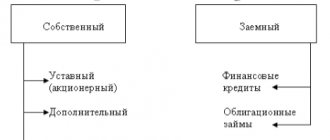Initially, the property of an enterprise is created at the expense of property that is transferred to it by the founders (contributions, shares, contributions). Property increases in the course of economic and production activities. It can be the object of various economic and legal transactions, mortgaged, alienated, etc.
In most cases, the property of an enterprise is separate from the property of the persons acting as its founders, participants or employees. The enterprise is obliged to answer for its debts with its property. It may be subject to various legal claims by creditors and partners in cases of failure to fulfill certain obligations that the enterprise has assumed.
The property of an enterprise is the entire property complex used in the course of carrying out economic entrepreneurial activities. In general, an enterprise is recognized as real estate as a property complex. It includes all types of property that are intended for the implementation of its activities. It includes land plots, structures, buildings, raw materials, equipment, inventory, rights of claim, products, debts, rights to designate the enterprise and its products (company name, service marks, trademarks), as well as other rights of an exclusive nature.
The property of the enterprise and its composition are determined as follows. It is divided into immovable and movable. It may be owned, managed or operated by the enterprise.
The real estate of an enterprise is subsoil plots, land plots, water bodies, as well as everything related to the land (that is, objects that cannot be moved without disproportionate damage to their main purpose, including perennial plantings, buildings, forests, structures). This same group of property includes state-registered space objects, ships, sea, air, and inland navigation.
Movable property of an enterprise is all property that does not fall under the first group. This includes money and securities. These objects do not require registration of rights, except as otherwise provided by law.
Income received by an enterprise as a result of the use of property owned by it belongs to the enterprise, unless otherwise prescribed by law.
Transactions of legal entities on the alienation of property can only be concluded in writing signed by the persons making these transactions.
All property of the enterprise, which is reflected in the balance sheet, is divided into the following types . fixed assets and intangible assets, profit (loss), capital and financial investments, materials, deferred expenses, finished products, capital and reserves, work in progress, raw materials, settlements with debtors and creditors.
If an enterprise is declared bankrupt, property can legally be used to satisfy the claims and demands of creditors. After this, the remaining property can be transferred to the founders or participants who have real or liability rights to it.
To survive and prevent bankruptcy, you need to know how to competently manage the property of an enterprise, what share should be your own funds and borrowed funds. An analysis of the enterprise's property plays a major role in resolving these issues.
According to the law, the founders of an enterprise have obligatory rights to the property of business partnerships, as well as production cooperatives. If enterprises are state or municipal unitary, as well as subsidiaries, then the founders initially have ownership or other property rights to them.
9 foods you shouldn't eat or drink after 9 pm Your sleep should be sweet, but what you eat before it is not. Whether you want to lose weight or gain muscle mass, from.
Unforgivable Movie Mistakes You Probably Never Noticed There are probably very few people who don't enjoy watching movies. However, even in the best cinema there are mistakes that the viewer can notice.
11 Weird Signs That You're Good in Bed Do you also want to believe that you please your romantic partner in bed? At least you don't want to blush and apologize.
15 Cancer Symptoms Women Most Often Ignore Many signs of cancer are similar to symptoms of other diseases or conditions, which is why they are often ignored. Pay attention to your body. If you notice.
Our ancestors slept differently than we do. What are we doing wrong? It’s hard to believe, but scientists and many historians are inclined to believe that modern man sleeps completely differently than his ancient ancestors. Initially.
20 uses of a microwave that will definitely surprise you Anyone who uses a microwave only to heat food or water doesn’t really know how to use it. Read on for some unusual ways.
The property of the organization is assets and liabilities.
Before getting to the most interesting part, namely accounting accounts and postings, you need to understand what the property of the enterprise is. We will deal with this issue in this article; more specifically, we will understand such concepts as assets and liabilities of an enterprise. What are assets and what are liabilities? If you can answer this question yourself without any problems, then you can safely skip this article and move on to the next one. Those who do not see much difference between these two concepts or doubt what this or that property of the enterprise belongs to should carefully study the information presented below. Assets and liabilities are what all accounting is based on.
Everything that an organization has (fixed assets, materials, debts, cash) is divided into assets and liabilities. It is very important to learn how to accurately determine whether it is an asset or a liability when looking at an enterprise object. Why is this so important?
How to classify correctly
Since 2013, rules have been in force according to which it is necessary to indicate that an acquisition belongs to a certain category (movable/immovable property) in accounting immediately after the purchase. As a rule, there are no problems with obvious objects such as construction equipment or cars. These things are clearly classified as movable property.
Article 130 of the Civil Code defines real estate. It says that it refers to everything that is inextricably linked with the earth. That is, in theory, no questions should arise when classifying the structure. Is this property movable or immovable? If there is a capital foundation, then it is classified as real estate.
What is the problem then? It lies in the fact that in accounting and civil law the concept of these objects is different. For example, the Civil Code operates with the concepts of “complex” and “indivisible thing,” while there are no such definitions in accounting.
The same Civil Code states that if several things form one whole and are used for a single purpose, then it will be called a complex thing. When it is impossible to divide an object without changing its meaning, the thing is considered indivisible.
There are no such concepts in accounting, but all things are called inventory objects. This can be either a separate element that performs its functions, or an object with all the accompanying devices.
It turns out that an indivisible thing, according to the concepts of civil law in accounting, will look like several inventory objects that have different useful lives.
To make it clearer, let's give an example. Let's take a building with communications as a basis. The Civil Code calls such an object an indivisible thing. While in the State Standard of 1994 the building will be considered in parts. That is, there will be a sewerage and gas pipeline network, an electrical network, a signaling network, telephone and others.
Difference between liability and asset:
Those objects that an enterprise owns and which it uses in economic activities to make a profit are called assets. That is, this is all the property of the enterprise with the help of which the enterprise plans to make a profit.
For example, a machine tool is a main tool used in production activities to create products and resell them.
Securities are also an asset, since it is planned to make a profit from them in the future.
Raw materials, materials - similarly, are used in production for further profit.
Goods are purchased for the purpose of their further resale and receipt of revenue.
Finished products are the same.
Accounts receivable is a debt owed to an enterprise by other counterparties, that is, these are funds that the organization plans to receive in the future, that is, also the economic benefit of the enterprise.
Cash - I think it’s clear that this is an asset that the company will invest in the future in the purchase of goods, production, etc. for the purpose of making a profit.
A warehouse is also an asset, as it is used to store goods that the company later sells for profit.
Assets do not suddenly appear out of thin air, they all come from somewhere, their sources of origin are liabilities. Thus, liabilities form assets, let’s confirm this by analyzing several examples:
Authorized capital – contributions of the founders, which become the start-up capital in the activities of the enterprise (that is, the liability “authorized capital” forms the asset “cash, goods and materials”, depending on how the contributions of the founders are made).
Loans are another liability; as a result of taking a loan, we receive money with which we can buy goods, repair a machine, build a new office, etc. That is, credit is a source of asset formation.
Additional capital is additional financial assets that appear in the course of the organization’s activities, for example, due to the revaluation of fixed assets. These funds will be a source for, say, the purchase of materials for production, that is, undoubtedly, additional capital is a liability.
Retained earnings are the organization’s net profit for the year; in the future it can be used for the purchase of materials, fixed assets or their modernization, repairs, etc. accordingly, it is also a liability.
Now let’s summarize what belongs to the assets of the enterprise and what to liabilities.
- movable and immovable property;
- fixed and production assets;
- inventory items;
- cash;
- accounts receivable;
- securities.
- authorized capital;
- retained earnings;
- reserves;
- loans and borrowings from other enterprises and individuals;
- accounts payable;
- taxes, etc.
The assets and liabilities of an enterprise are closely related to each other. If the first ones change, then, accordingly, the second ones change by the same amount. Moreover, as assets increase, liabilities also increase by the same amount. The same goes for decreasing. That is why in the balance sheet the total amount of assets must be equal to the total amount of liabilities.
To track the process of simultaneous changes in both quantities, and also to confirm the equality of liabilities and assets, consider an example.
An organization buys goods for sale for 100,000 rubles. The goods will be an asset of the enterprise; as a result of the purchase of goods, the assets of the enterprise increased by 100,000 rubles. (the product is in stock). At the same time, a receivable from the enterprise to the supplier of goods appeared in the amount of 100,000 rubles. this debt is a liability of the enterprise, that is, as a result of the purchase, liabilities increased by 100,000 rubles. The example confirms the above words.
Let's continue our example a little: the company pays the debt to the supplier in the amount of the same 100,000 rubles. As a result of this business transaction, the amount of funds in the organization’s current account decreased (that is, assets decreased by 100,000 rubles), while the amount of receivables to the supplier decreased (that is, liabilities decreased by the same 100,000 rubles). Again the rule is confirmed: when assets decrease, liabilities also decrease by the same amount.
There are a great many such examples. All of them will confirm the same rule: the total amount of assets in an enterprise is always equal to the total amount of liabilities. If at the end of the year the assets and liabilities of the balance sheet revealed discrepancies in these indicators, then somewhere you made a mistake. Most likely, some business transaction was not reflected correctly, that is, the posting was not drawn up correctly, the accounting accounts for this posting were not selected correctly.
Accounting problems
We have already said above that movable and immovable property in accounting differs from the same terms in civil law.
For example, if real estate with communications in accounting is considered one inventory item, then the tax will need to be calculated for everything. It is important to remember that state registration is not required to register for accounting or tax purposes.
If the building and common property are registered separately, then the useful life will be different. But in any case, two objects will be classified as real estate, even though one of them does not have an inextricable connection with the land.
The tax will be calculated from the value of the common property and the house itself.
The accountant has the right to choose the option for accounting for real estate. But during his activities he is obliged to rely on the opinion of regulatory authorities.
For example, utility systems and a building will be accounted for as separate entities, and each will have its own useful life. Of course, they are very different, for this reason the cost of communications will be written off much faster than buildings.
Despite the fact that such objects are more related to movable property, the relevant authorities still propose to tax them.
Enterprise property: concept and types
The generalized concept of an enterprise’s property is what it owns: fixed capital and working capital, expressed in monetary form and reflected in the enterprise’s independent balance sheet.
Information about the assets of an enterprise and its financial resources is considered in two aspects - accounting and management. The accounting aspect shows the balance of the enterprise’s assets and its financial resources, and the managerial aspect shows their form (productive, commodity, monetary) and their role in business activity. The assessment of the competitiveness of an enterprise is carried out based on the minimum volumes of assets spent in the process of economic activity per unit of finished product and the minimum balance of permanently assigned assets on the balance sheet of the enterprise, which provide the maximum volumes of business objects.
The assets of an enterprise can be divided into cash and real property. Through investment, funds are transformed into tangible forms of property and vice versa, in the process of selling things create a monetary form of property. Changes in the size of the enterprise's property are carried out through self-financing and by attracting borrowed funds.
Classification of enterprise property
can be carried out on various grounds, highlighting:
movable and immovable property;
property involved in production activities and non-production purposes. In addition to its economic significance, this classification is taken into account when deciding on the calculation of depreciation charges on fixed assets and the repayment of the value of intangible assets;
by type of turnover ability, property is distinguished that is withdrawn from circulation, has limited turnover ability, and that which can be freely alienated and transferred from one person to another;
fixed, working capital - depending on their participation in the production process, the procedure for transferring their value to the cost of manufactured products in parts or in one production cycle, duration of use, value of objects;
tangible (fixed and current assets) and intangible assets. A distinctive feature is the material content of the former and the immaterial form of the latter. Fixed assets and intangible assets also have common characteristics, for example, the possibility of long-term use, the presence of a certain value and the ability to generate income.
classification of property by risk categories during the analysis process
:
minimal risk – cash, easily marketable short-term securities;
low risk – accounts receivable of an enterprise with a stable financial position, inventories of goods of material value, finished products in demand;
medium risk – industrial and technical products, work in progress, deferred expenses;
high risk – accounts receivable from enterprises in difficult financial situations, inventories of finished products that are no longer in use, illiquid assets.
The simplest and most accessible classification of property (assets) is as follows:
current current mobile assets: current assets; expenses; stocks; cash; finished products; accounts receivable; Future expenses .
immobilized non-current assets: fixed assets; intangible assets; short-term investments.
The property of an enterprise appears, on the one hand, in cash or in kind, and on the other hand, in the form of its own or someone else’s. This ambiguity is determined by the structure of the enterprise's balance sheet. If you look from the liability side, you can distinguish the enterprise’s own property, that is, those things that the owners of business entities create for themselves, and someone else’s property, which is formed through loans.
There is such a thing as mobilization property . This is property owned by the organization and used by it to carry out mobilization tasks. The classification of company property as mobilization property is carried out only to the extent necessary to complete such tasks (orders).
Mobilization capacities, depending on the degree of their utilization in peacetime, are divided into three types: used entirely in current production, not used at all, or used partially. In the last two cases, mobilization capacities must be maintained in conditions that ensure their safety and readiness to carry out mobilization tasks (orders).
The above norms are enshrined in paragraphs 2.1 and 2.2 of the Regulations on the procedure for economic stimulation of mobilization preparation of the economy (approved by the Ministry of Economic Development of the Russian Federation No. GG-181, by the Ministry of Finance of the Russian Federation No. 13-6-5/9564, by the Ministry of Taxes of the Russian Federation No. BG-18-01/3 02.12.2002).
Bibliography:
- Gruzinov V.P. Gribov V.D. Enterprise Economics: Textbook. - M. Finance and Statistics, 2002.
- Keiler V.A. Enterprise economics: Course of lectures. - M: INFRA-M-NGAEiU, 2002.
- “Regulations on the procedure for economic stimulation of mobilization preparation of the economy”, approved by the Ministry of Economic Development of the Russian Federation No. GG-181, the Ministry of Finance of the Russian Federation No. 13-6-5/9564, the Ministry of Taxes of the Russian Federation No. BG-18-01/3 12/02/2002
How strong is your connection to the earth?
Article 130 of the Civil Code provides one of the key criteria for classifying property as real estate - a strong (primarily physical) connection with the land. Its essence is as follows: if an object can be moved from one place to another without disproportionate damage to its purpose, it is recognized as movable property. In this case, there is no strong connection with the ground.
The question in the title is not an empty cry. In judicial practice, one can find quite a lot of disputes when individuals or organizations try to prove that an object they own (an extension, a garage, a fence, a building, communications, etc.) is real estate. After all, if the court recognizes the constructed object as movable property, the consequences of such a decision will certainly result in significant financial costs. Moreover: it is impossible to register rights to such property, and if they are already registered, the court will invalidate the registration. Since the property is movable, it means that making the decision to demolish or move it is much easier. And at the same time, it should be borne in mind that only real estate can be recognized as unauthorized construction (clause 1 of Article 222 of the Civil Code of the Russian Federation). Let us give two examples from judicial practice: similar, but different in consequences.
Example 1
The foundation of the trade pavilion is strip, with lightweight sandwich-type wall panels. Thus, there are no signs of real estate. There are no grounds for registering ownership of a shopping pavilion and recognizing it as an unauthorized construction (resolution of the Federal Antimonopoly Service of the Volga-Vyatka District dated April 20, 2009 in case No. A38-1050/2008-15-87).
Example 2
According to the technical passport, the trade pavilion is a building with a concrete columnar foundation and has walls in the form of three-layer sandwich panels, partitions made of prefabricated panels, a pitched iron roof, plank floors covered with fiberboard, linoleum, and metal-plastic window openings. The building is provided with central heating, water supply and sewerage. Consequently, the pavilion is firmly connected to the ground. Relocation without disproportionate damage to its purpose is impossible. In this regard, the structure is real estate, is recognized as an unauthorized construction and is subject to demolition (Resolution of the Federal Antimonopoly Service of the Far Eastern District dated August 10, 2010 No. F03-5467/2010 in case No. A04-8600/2009).
Keep in mind: in order to classify an object as real estate, in addition to a strong connection with the land, it is necessary that it be created in the prescribed manner as real estate with the receipt of the necessary permits and in compliance with urban planning norms and rules. Thus, a strong connection with the land is only one of the signs by which an object can be classified as real estate. Here we can add, for example, another essential criterion - the presence of stationary communications.
The presence of a foundation cannot clearly indicate the immovable nature of the property. A similar position can be found in decisions of arbitration courts. Thus, in the resolution of the Federal Antimonopoly Service of the West Siberian District dated November 18, 2008 No. F04-7013/2008 (15948-A46-9) in case No. A46-5563/2008 it is stated: the presence of a foundation on which the trade pavilion is installed cannot serve the basis for classifying this pavilion as real estate.
At the same time, the Town Planning Code contains the concept of “capital construction object” (clause 10 of article 1). This is a building, structure, structure, objects whose construction has not been completed (unfinished construction objects), with the exception of temporary buildings, kiosks, sheds and other similar structures. Note that this concept is not identical to the concept of “real estate property,” although it is also not limited to the criterion of a strong connection with the land.
Do not forget that sooner or later the second part of the Tax Code will be supplemented with a chapter on real estate tax, which will replace property tax and land tax. In this regard, the issue of recognizing various buildings as movable or immovable property will become more acute.
For your information
In order for one of the spouses to make a transaction to dispose of common real estate (sell, exchange, donate, etc.), it is necessary to obtain the notarized consent of the other spouse (Clause 3 of Article 35 of the Labor Code of the Russian Federation). This rule does not apply to movable property.
Registration of rights
The legal regime of real estate is based on the need to ensure special stability of rights to this property and establish a special procedure for its disposal. Therefore, ownership and other real rights to real estate are subject to state registration in the Unified State Register of Rights (USRR), which is maintained by Rosreestr. In practice, it is enough to take the first step - submit documents for registration.
1.1. Real estate
State registration of rights to real estate is a mandatory condition for legalizing rights to it. Moreover: the right of ownership to newly created real estate arises only from the moment of such registration. This principle is enshrined in Article 219 of the Civil Code.
Federal Law No. 122-FZ of July 21, 1997 “On state registration of rights to real estate and transactions with it” is the main regulatory document that defines the general rules and procedure for state registration. This law should be consulted if it is necessary to carry out state registration of the following types of real estate and rights to it:
– enterprises as a property complex and transactions with it;
– rights to hydraulic engineering and other structures located on water bodies;
– rights to land plots formed during the division, merger, redistribution of land plots or separation from land plots;
– rights to real estate and transactions with it in apartment buildings;
– common ownership rights to real estate;
– ownership rights to the real estate object being created;
– agreements for participation in shared construction and the rights of participants in shared construction to shared construction objects;
– a citizen’s ownership rights to a land plot provided for personal subsidiary farming, dacha farming, vegetable gardening, horticulture, individual garage or individual housing construction;
– ownership rights to some real estate objects being created or created;
– citizen’s property rights to an individual housing construction project;
– rental of real estate;
– easements (the right to limited use of someone else’s land plot);
– rights to real estate established by a court, arbitration or arbitration court decision;
– mortgages;
– any rights to real estate related to its disposal under the terms of trust management or guardianship;
– ownership rights to a land plot when delineating state ownership of land;
– termination of ownership of a land plot due to abandonment of ownership rights to it.
Legal regulation of state registration of real estate is not limited by this law. For example, a separate Federal Law of March 14, 2009 No. 31-FZ “On state registration of rights to aircraft and transactions with them” applies to aircraft. A separate chapter is devoted to issues of state registration in the Federal Law of July 16, 1998 No. 102-FZ “On mortgage (real estate pledge)”.
The procedure for state registration of aircraft and sea vessels, inland navigation vessels, and space objects is regulated by various codes (Air Code, Merchant Shipping Code, Inland Water Transport Code), as well as other laws and departmental orders.
Thus, not only the right of ownership of real estate is subject to state registration, but also other rights (economic management, operational management, lifelong inheritable ownership, permanent use, mortgage, lease, etc.), as well as restrictions on these rights (easements), their occurrence , transition and termination.
Attention
The rules on unauthorized construction (Article 222 of the Civil Code of the Russian Federation) apply exclusively to objects that meet the criteria of real estate.
Accounting for certain types of such property should be distinguished from state registration of real estate and rights to it. In this case, we are talking about the technical accounting of the housing stock (BTI), as well as the accounting of other capital construction projects and separately federal property according to the Regulations on the accounting of federal property (approved by Decree of the Government of the Russian Federation of July 16, 2007 No. 447).
1.2. Movable property
As a general rule, there is no need to register rights to movable things. However, the law provides for special cases. For example, weapons.
1.2.1. Weapon
According to Federal Law No. 150-FZ of December 13, 1996 “On Weapons,” purchased weapons are subject to registration with the internal affairs agency within two weeks from the date of their acquisition. When registering weapons, legal entities with special statutory tasks are issued a permit to store and use these weapons for a period of three years on the basis of documents confirming the legality of the acquisition of weapons.
It is especially noted that enterprises and organizations that are entrusted by law with functions related to the use and use of service weapons are recognized as legal entities with special statutory tasks.
1.2.2. Road transport
It wouldn’t hurt to dot all the i’s regarding vehicles. Many people believe that a car is real estate. This is wrong. All vehicles are classified as movable things (except for aircraft and sea vessels, inland navigation vessels, and space objects). Paragraph 3 of Article 15 of the Federal Law of December 10, 1995 No. 196-FZ “On Road Safety” states: the admission of vehicles to participate in road traffic is carried out by registering vehicles with the State Traffic Safety Inspectorate and issuing the relevant documents (registration certificate, registration signs, etc.). This applies to cars, motorcycles, trailers, etc.
Attention
The right of ownership of buildings, structures and other newly created real estate, subject to state registration, arises from the moment of such registration (Article 219 of the Civil Code of the Russian Federation). Namely, from the moment the corresponding entry is made in the Unified State Register.
1.2.3. Outlets
In arbitration practice one can find quite a few examples related to determining the property status of retail outlets. Depending on whether the trade pavilion is real or movable property, the obligation or impossibility of state registration of rights to it and agreements for the disposal of it as a whole or individual parts (for example, leasing) arises.
Thus, by the ruling of the Supreme Arbitration Court of the Russian Federation dated August 5, 2010 No. VAS-9213/10 in case No. A40-98414/09-3-780, the judges came to the conclusion that the disputed shopping pavilions do not have the characteristics of real estate. In this regard, information about the rights to these premises (ownership and common shared ownership) and transactions with them (purchase and sale) are not subject to inclusion in the Unified State Register. It was established that the land plot on which the premises are located was provided by order of the prefect for the placement and operation of a trade pavilion made of prefabricated structures, and not for the construction of a permanent building. In fact, the structures were erected without obtaining permission to build real estate, in the absence of the will of the owner of the land (prefecture), who provided it for the construction and operation of a prefabricated shopping complex. The pavilion was not accepted for use as a real estate property.
It is important
The object of unfinished construction can be not only a building, but also a structure or structure. This legal term characterizes not the design features of a real estate object and the functional purposes of its creation, but the creation process itself and the reflection of the stages of this process in the properties of the created object.
1.2.4. Communications and infrastructure
Often, disputes arise about who owns the infrastructure object and whether there is a need for state registration of the right to it (otherwise, a contract, for example, a purchase and sale with an act of acceptance and transfer, is sufficient). As a rule, we are talking about heat, water and gas supply, transformer stations, etc.
An illustrative example is the resolution of the Federal Antimonopoly Service of the Volga-Vyatka District dated November 30, 2009 in case No. A43-18877/2007-12-531. The arbitrators had to establish the existence of the company's ownership of the disputed heating networks and the need for state registration of the right to them. In particular, they studied the conclusion of a specialist from an architectural bureau and the conclusion of a construction expert from the Chamber of Commerce and Industry of the Russian Federation. The arbitrators' conclusion is as follows: heating networks do not have a strong and inextricable connection with the ground and can be dismantled and moved without disproportionate damage to their purpose. Dismantling, moving and installation of the specified heating networks on another land plot is possible. Moreover, the cost of these works is less than the cost of creating new heating networks with similar technical characteristics. Thus, the judges classified the disputed property as movable.
1.2.5. Garage
In many cases, a garage is also recognized as movable property. For example, the ruling of the Supreme Arbitration Court of the Russian Federation dated March 30, 2010 No. VAS-3709/10 in case No. A64-3043/09 recognized that a garage consisting of a brick foundation, metal external and internal main walls, a metal roof and similar gates , is not real estate. And therefore, the right to it is recognized not by the owner of the land plot, but by the organization that owns the plot on the right of permanent (indefinite) use.
Moreover: in the resolution of the Federal Antimonopoly Service of the Central District dated December 21, 2009 No. F10-5586/09 in case No. A64-3043/09 it is explained that the impossibility of moving the said garage without disproportionate damage to its purpose has not been proven. Thus, the arbitrators brought the said garage under the concept of “temporary construction” and recognized it as movable property. And this is despite the fact that the applicant gave the following arguments: the garage is a permanent structure, has undergone a technical inventory, is registered with the State Unitary Enterprise for Technical Inventory (GUPTI), and has been assigned an address. In addition, a GUPTI certificate confirms that the garage is real estate.
Enterprise property
Enterprise property - tangible and intangible elements used by the enterprise in production activities.
The property of an enterprise is initially created from property transferred to it by the founders in the form of contributions (contributions, shares). The property of the enterprise increases in the process of production and economic activities. It can be the object of transactions, alienated, mortgaged, etc.
Typically, the property of an enterprise is separate from the property of its founders, participants and employees. An enterprise is liable for its debts with property that belongs to it, which may be subject to claims by business partners or creditors in the event that the enterprise fails to fulfill any obligations to them.
If an enterprise is declared insolvent (bankrupt), its property, in accordance with the procedures established by law, can be used to satisfy the claims of creditors. The remaining property of the liquidated enterprise after this is transferred to its founders (participants) who have real rights to this property or rights of obligations in relation to the enterprise. According to Russian legislation, the founders and participants of an enterprise have rights of obligations in relation to business partnerships and companies. production cooperatives. For the property of state and municipal unitary enterprises. as well as subsidiaries, the founders have the right of ownership or other proprietary rights.
What are the exceptions?
There are cases when it is allowed to classify inventory objects that are part of the real estate and are functionally connected to the building as movable property. A striking example is the situation when production equipment is installed on the base of a building, which can only be operated as part of a whole complex. It turns out that since the equipment is located on the foundation, it cannot be moved without damaging underground communications. But, on the other hand, it can be dismantled and transferred to a new location, where it will work as before.
The Ministry of Finance believes that such a machine does not belong to an immovable object, and therefore no tax is levied. To be on the safe side, you need to look at what kind of foundation is poured. If, according to technical documents, the foundation is not part of the structure, then the cost of pouring it is included in the cost of the equipment and is not taken into account when calculating the tax.
If the foundation is the basis, the equipment is considered real estate.








